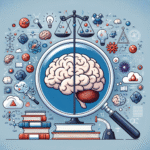
Introduction
In a world where mental wellness and cognitive performance are highly prized, understanding the intricate workings of the human brain has never been more vital. Beyond the Surface: Exploring the Depths of Brain Activity with EEG delves into the realm of electroencephalography (EEG), a technology that provides a non-invasive window into our brain’s activities. This article will guide you through the complexities of EEG, illustrating its significance with real-world applications and insights that resonate far beyond mere surface-level understanding.
The Foundation of EEG Technology
What is EEG?
Electroencephalography (EEG) is a method used to record electrical activity in the brain. By placing electrodes on the scalp, scientists can measure voltage fluctuations resulting from ionic current flows within the neurons of the brain. This non-invasive technique allows researchers and clinicians to examine brain states, diagnose neurological disorders, and understand cognitive processes in real-time.
How EEG Works
EEG captures brain signals in the form of wave patterns, generally categorized into five types:
| Wave Type | Frequency (Hz) | Associated State |
|---|---|---|
| Delta | 0.5-4 | Deep Sleep |
| Theta | 4-8 | Light Sleep, Drowsiness |
| Alpha | 8-12 | Relaxed Wakefulness |
| Beta | 12-30 | Active Thinking, Problem Solving |
| Gamma | 30+ | High-Level Cognitive Function |
This classification emphasizes the depth of brain activity, showcasing how oscillatory patterns correspond to different mental states.
Exploring EEG’s Applications
Clinical Uses
EEG plays a crucial role in diagnosing various conditions, including epilepsy, sleep disorders, and brain injuries. For instance, a study involving epilepsy patients highlighted the power of Beyond the Surface: Exploring the Depths of Brain Activity with EEG technology in identifying seizure types through detailed wave analysis.
Case Study: Investigating Epilepsy
In a controlled setting, researchers monitored patients during seizure activity. By applying an EEG protocol, they could pinpoint the specific brain regions involved, leading to more targeted treatment options. This case study exemplifies the profound impact EEG has on improving patient care and tailoring therapies.
Psychological and Cognitive Research
Beyond clinical diagnostics, EEG is instrumental in cognitive psychology. It sheds light on attention, memory, and decision-making processes. Researchers have utilized EEG to investigate how different stimuli affect brain responses.
Case Study: Attention and Mental Load
A study examined students’ brain activity while solving complex mathematical problems. Through EEG monitoring, researchers discovered that increases in cognitive load led to heightened beta wave activity. This insight demonstrates how Beyond the Surface: Exploring the Depths of Brain Activity with EEG can inform educational strategies and learning techniques.
Enhancing Cognitive Performance
Neurofeedback Training
EEG-based neurofeedback training is revolutionizing how we approach mental performance. By providing real-time feedback on brain activity, individuals can learn to modulate their brain waves and improve cognitive functions, such as focus and creativity.
Case Study: Athletes and Neurofeedback
Athletes have begun embracing EEG neurofeedback to enhance performance. A study involving professional golfers found that targeted training led to significant improvements in their focus and consistency under pressure. This showcases the transformative potential of Beyond the Surface: Exploring the Depths of Brain Activity with EEG in optimizing performance across various disciplines.
EEG’s Role in Mental Health
Understanding Mental Disorders
EEG has become a powerful tool in understanding and diagnosing mental health disorders, including anxiety and depression. By examining brain wave patterns, clinicians can gain insights into emotional regulation and cognitive dysfunctions.
Case Study: EEG in Anxiety Disorders
A groundbreaking study focused on patients with anxiety disorders. By analyzing their EEG patterns, researchers identified specific brain wave imbalances that correlated with anxiety levels. This understanding enhances treatment approaches, enabling targeted therapeutic interventions.
Innovations and Future Directions
Combining EEG with AI
The integration of artificial intelligence (AI) with EEG technology is set to revolutionize the field. Machine learning algorithms can analyze vast datasets, identifying patterns and correlations that human analysts may overlook.
Case Study: Predicting Mental States
Researchers have begun employing AI to predict states of mind based on EEG data. A recent study successfully developed models that could forecast anxiety levels with remarkable accuracy. This innovation encapsulates the essence of Beyond the Surface: Exploring the Depths of Brain Activity with EEG, pushing boundaries in mental health diagnostics.
Wearable EEG Devices
The advent of portable EEG devices makes brain monitoring more accessible than ever. These devices allow users to gain insights into their cognitive states in everyday situations, from work meetings to meditation sessions.
Challenges in EEG Research
While EEG has proven invaluable, it comes with limitations. Signal noise, the challenge of interpreting data, and the need for expert analysis can hinder its widespread use. Understanding these challenges is crucial for researchers and clinicians alike.
Addressing Common Concerns
What are the risks of EEG?
EEG is non-invasive and presents minimal risk. The only discomfort may arise from the electrode placement.How accurate is EEG?
While EEG provides valuable insights, it is best used in conjunction with other diagnostic tools for a comprehensive view.Can EEG be used for anyone?
Yes, EEG can be utilized across various populations, including children and elderly patients.How long does an EEG test take?
Typically, an EEG session lasts between 30 minutes to an hour, depending on the purpose.- What can parents expect when their child undergoes an EEG?
Parents can expect a comfortable and safe environment where their child will be monitored during a series of tasks.
Conclusion
Beyond the Surface: Exploring the Depths of Brain Activity with EEG has illustrated how this remarkable technology not only enhances our understanding of brain function but also paves the way for innovations in healthcare, psychology, and performance optimization. By transcending the limitations of traditional monitoring, EEG opens doors to a world of possibilities, enabling us to harness the full potential of the human mind.
With the rapidly evolving field of neuroscience, the future holds exciting prospects. By embracing the insights gained from EEG, we can foster mental well-being, improve learning, and unleash the power of the human brain in remarkable ways.
Let this article inspire you to delve deeper into the capabilities of EEG technology, whether for personal growth, professional understanding, or contributing to transformative research in the field.
FAQs
1. What is the average cost of an EEG?
EEG costs can vary significantly based on location and healthcare provider but typically range from $100 to $1,000.
2. Is EEG used for both clinical and research purposes?
Yes, EEG serves both clinical diagnostics and extensive research in cognitive and neurological sciences.
3. How does EEG compare to MRI in terms of brain monitoring?
EEG provides real-time temporal resolution, whereas MRI gives detailed structural imaging. They are often used together for comprehensive analysis.
4. Can EEG detect all types of brain activity?
While EEG is excellent for detecting certain brain wave activities, it may not capture all brain functions, particularly deeper areas of the brain.
5. What should someone do if they are interested in EEG technology?
For those interested, pursuing studies in neuroscience, psychology, or biomedical engineering can pave the way for a career in EEG research or application.
By broadening our knowledge of EEG, we open ourselves to innovative paths in mental health, cognitive enhancement, and overall understanding of our minds. Let’s dive deeper and continue exploring the fascinating field of brain activity!














